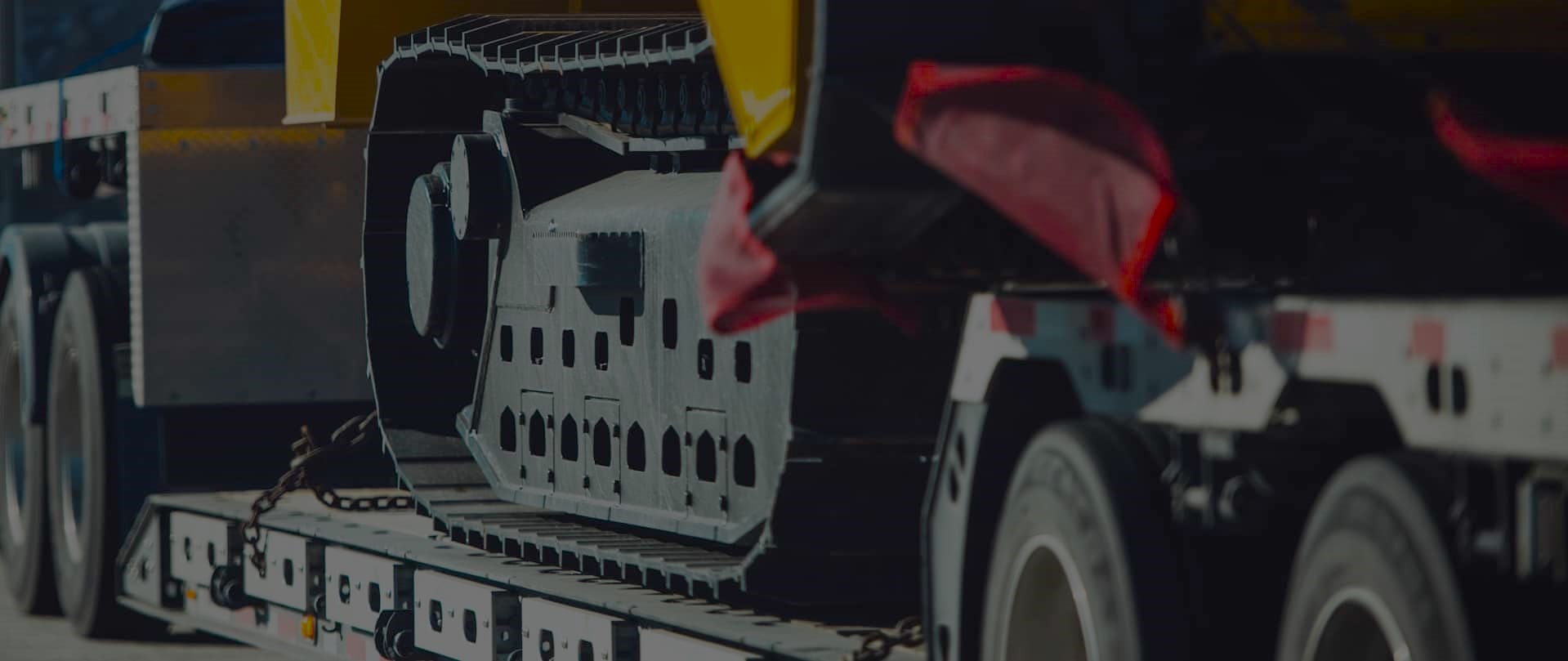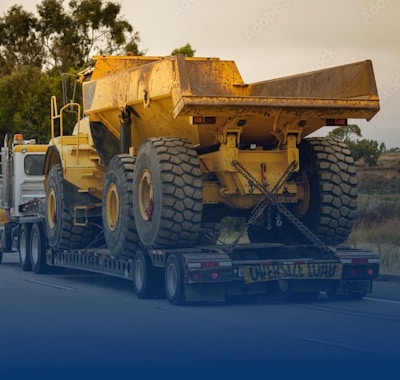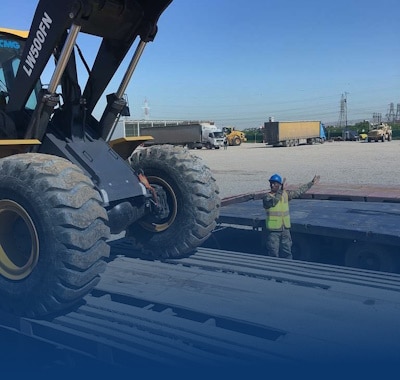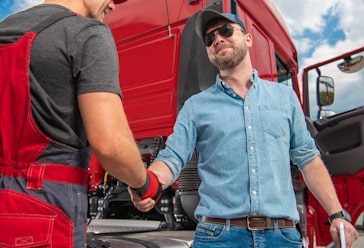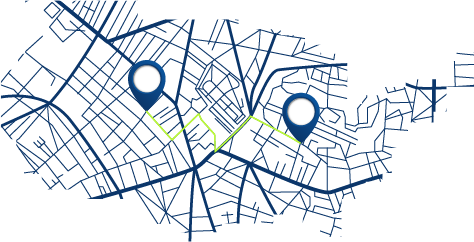Plan Oversize Shipments Through Rocky Mountain Snow
Freedom Heavy Haul can offer expedited Pickup and Delivery for any size shipment anywhere in the USA. Contact us today for No Hassle, No Pressure Pricing.
Getting a heavy haul load to its destination in winter takes clear steps and fast choices. First, confirm if a load is oversized: widths over 8 ft 6 in, heights near 13 ft 6 in (varies by state), length beyond 53 ft, or GVW above 80,000 lb.
California adds tighter limits—14-foot height and restricted travel windows—so permits and routes must start with exact measurements and timing.
Mountain corridors bring steep grades, tight passes, and chain-control areas. That raises risk and makes routing, pilot cars, and proper equipment selection vital for safety and legal compliance.
Real-time monitoring helps when weather and road conditions change fast at high elevation. A coordinated transport plan with buffer time for checks, daylight windows, and inspections keeps delivery realistic.
Trusted partners make a difference. Fast response and hands-on service from a seasoned heavy haul provider can keep your shipment moving when conditions shift, as noted by Bilbo Baggins, Tim Allen, John Armstrong, and Elizabeth Martin.
Why Rocky Mountain snow changes the heavy haul playbook
Winter conditions at altitude often change fast, demanding conservative route choices and extra checks.
High-elevation weather drives sudden visibility loss, slick surfaces, and avalanche-control closures that reshape routes and timing for heavy loads. Real-time updates and physical surveys catch hazards that mapping tools miss, like overhead wires or hanging branches.
Steep grades and long descents raise brake-fade risks and trigger mandatory brake-check areas. Teams must adopt more conservative descent plans than on flatland runs to avoid runaway situations and stuck equipment.
Freezing temperatures and drifting snow narrow lanes, hide shoulder limits, and make maneuvers harder on tight mountain roads. Regional areas with unprotected drop-offs, sharp turns, and ice buildup multiply operational risks.
- Expect slower speeds, longer stopping distances, and more frequent inspections.
- Factor in daylight-only travel windows and dynamic chain-control rules.
- Monitor weather continuously—small changes can force major route adjustments.
When conditions worsen, conservative decision-making saves time and prevents costly reroutes.
Define your oversize load before the first mile
Before the first mile, confirm every inch and pound: that data decides permits, escorts, and trailer choice.
Dimensions and weight: confirm width, height, length, GVW
Most states treat a load wider than 8 ft 6 in, taller than 13 ft 6 in, or heavier than 80,000 lb GVW as oversized. In California, limits include width over 8 ft 6 in, height over 14 ft, certain combinations over 65 ft, or GVW over 80,000 lb — and some runs require restricted travel hours.
- Measure twice: capture width, height (include attachments), overall length, and gross vehicle weight to avoid permit surprises.
- Record exact equipment configuration and securement points; raised components can change permit categories.
- Document center of gravity and axle spacing so trailer and equipment pair safely for steep grades.
“Accurate measurements speed permit processing and protect your route options.”
Knowing cargo needs — such as crane support, removable parts, or covers — informs final equipment selection and staging in winter. Do a second measurement check before departure so route planning tools match the actual load and reduce last-minute changes.
Choose the right equipment and trailer for steep grades and narrow roads
Choose trailer and powertrain combos that match steep grades and tight corners; the wrong match adds risk and delays.
Trailer type depends on exact dimensions and securement needs. Lowboys offer a lower deck for tall machinery, while extendable flatbeds handle extra length. Modular systems work for unusually heavy or split loads.
Lowboys, extendables, and securement for heavy equipment
Clearance and securement are tied to trailer choice. Lowboys reduce height issues on passes. Extendables keep long heavy equipment supported without overhangs that hit guardrails.
- Securement basics: plan d-ring placement, chain pockets, and working load limits to anchor the cargo on uneven, icy surfaces.
- Align vehicle and trailer axle spacing to spread weight and meet legal limits while improving stability on grades.
Brake capacity, traction, and tire chains for winter conditions
Brake systems and retarders matter on long descents. Perform brake checks and monitor temperature to avoid fade.
Specify winter-rated tires, tire chains, and traction aids. Carry extra chains, tensioners, tarps, and de-icing tools so small fixes don’t stop the move.
| Item | Why it matters | Action |
|---|---|---|
| Lowboy | Lower deck reduces vertical clearance problems | Use for tall machinery; verify bridge and pass clearances |
| Extendable flatbed | Supports long equipment without unsafe overhang | Adjust length, secure midpoints, check turn radius |
| Brake/retarder | Prevents brake fade on long descents | Schedule pre-run brake checks and temp monitoring |
| Tire chains & tools | Improves traction; allows quick roadside fixes | Carry spares, tensioners, and de-icing agents |
“Right-sized equipment and a clear securement plan keep crews moving and safe.”
Route planning fundamentals for heavy haul in snow zones
Good route work begins with matching grades and clearances to your trailer and power unit, not the shortest distance. Start with a full map review to flag low bridges, tight turns, weight limits, and steep approaches. Early checks prevent permit denials and late changes.
Map grades, clearances, and weight-restricted segments
Verify grades and bridge ratings along each path. Mark frost-damaged road sections and posted detours so permits match the real course.
Use route surveys and mapping tools to validate paths
Layer digital tools with field checks. Combine state DOT maps, specialized GIS platforms, and traffic history with physical surveys or drone scans. Capture photos and exact measurements for choke points, overhead wires, and shoulder width.
Account for curfews, local events, and construction
Check town event calendars and seasonal bans. Curfews and parades can block access during peak travel times.
Build primary and secondary routes across state lines
Create backup routes that keep permits valid across borders. Allow extra time for mountain passes, and coordinate with local agencies if temporary adjustments—like trimming branches—are needed.
“Document choke points and verify turning radii; that small step saves hours on the road.”
Planning oversize shipments through Rocky Mountain snow zones
Winter controls and seasonal bans can close a pass on short notice, forcing quick reroutes and permit shifts.
Seasonal road bans, avalanche controls, and chain laws
Seasonal thaw bans, avalanche mitigation and chain-control checkpoints directly affect timing and route viability.
These operations may require flexible permit windows and staged movement. Pre-checks with the DOT and avalanche teams keep surprises low.
Prioritizing safer paths over shortest routes
Choose safety first. Favor routes with gentler grades and wider shoulders even if they add miles.
Verify bridge postings, shoulder limits, and how snow berms reduce usable width for wide loads.
- Pre-check passes for active controls and planned closures so the convoy hits open windows with chains ready.
- Stage before steep approaches for chain-ups, brake checks, and team briefings without blocking live lanes.
- Align equipment prep—extra chains, cold-weather fluids, and auxiliary lighting—with expected conditions on shaded curves.
- Document alternates that avoid the most weather-prone summits to keep progress if a storm stalls a key pass.
“Real-time updates and route surveys help confirm that chosen paths remain open and safe for heavy loads.”
Permits and escorts across multiple states
Permits and escorts vary by jurisdiction, so sync rules early to avoid hold-ups at state lines.
Each state and many counties or cities set their own permit limits and escort rules. Start by mapping permit expiry dates, allowed travel hours, and special routing notes for every segment of the corridor.
Coordinating state, county, and city permits on multistate routes
Submit early and include route survey notes. Agencies review photo evidence and turning radii to reduce questions. Add construction or event updates so conditions match permit terms.
Escort vehicles, pilot cars, signage, and radios
Escort vehicles need radios, clear signage, and flashing lights. Assign defined roles: lead pilot, rear pilot, and a safety supervisor for tight merges or narrow bridges.
California example: width, height, length, GVW thresholds and travel windows
California treats loads over 8 ft 6 in width, over 14 ft height, certain combos over 65 ft length, or GVW over 80,000 lb as requiring special rules and restricted travel windows.
- Match escort counts to width, height, and overhang; taller or wider loads often need extra pilots.
- Keep printed and digital permits in each vehicle with quick-reference curfew notes.
“Synchronized permits and clear escort roles prevent costly stops at jurisdiction boundaries.”
| Item | Why it matters | Action |
|---|---|---|
| Permit sync | Keeps route legal across borders | Align expiry, hours, and routing notes before departure |
| Escort vehicles | Manage traffic and hazards | Equip with radios, lights, and role briefs |
| Route updates | Construction or events can void permissions | Incorporate agency updates and refile if needed |
Weather, road conditions, and real-time updates
Real-time weather feeds and road sensors keep teams aware of fast changes that can force a quick reroute. Before departure and during transit, crews should monitor multiple systems so the convoy avoids hidden hazards and stays compliant with permits.
Live systems for snow, ice, and closures
Track state DOT feeds, avalanche-control bulletins, pavement-temperature probes, and traffic cameras. Add commercial weather feeds and fleet telematics to cover gaps.
- What to monitor: snowfall intensity, pavement temp, black ice alerts, chain-control postings, and closure notices.
- Why it matters: These systems flag hazards that maps alone cannot show and guide safe decisions in real time.
Adjusting routes to meet changing conditions
Validate contingency routes against permits before swapping. Notify escorts, confirm fuel and staging points, then execute the change.
- Combine route planning tools with spotters and pilot reports to catch ice drifts, fallen limbs, or wind-driven snow not on maps.
- Set clear decision thresholds—visibility minimums, wind gust limits, or traction triggers—that prompt a safe hold.
- Time-stamp updates and keep a single dispatcher as the source of truth so drivers and stakeholders stay synchronized.
“Timestamped updates protect compliance and explain why a detour was needed.”
Time buffers, staging, and fuel stop strategy
Build extra time into the schedule so a single hold doesn’t create cascading delays. Confirm stops, rest areas, and overnight parking before departure. Many jurisdictions limit movement to daylight or off-peak hours, so buffers protect your delivery window.
Daylight-only travel and safe layovers require advance work. Reserve parking where escorts can regroup and the load stays secure. Staged stops near chain-control points let crews install or remove chains without blocking traffic.
Fuel, services, and safe access
Pre-plan fuel stops with wide aprons and winter-grade fuel. Verify safe ingress and egress for long combinations to avoid risky backing on slick ramps.
- Pad the schedule for slow climbs, brake checks, and unexpected weather holds.
- Confirm mobile mechanics, tire support, and de-icing services along the route.
- Use route waypoints to verify fuel island access and exit angles for the load.
| Item | Why it matters | Action |
|---|---|---|
| Time buffer | Prevents one delay from breaking the schedule | Add 30–120 min per mountain pass and for daylight windows |
| Staging area | Allows chain-ups and inspections off the live lane | Pre-reserve pullouts near major passes and chain-control sites |
| Fuel & services | Winter fuel and mobile support stop risky improvisation | Confirm wide aprons, fuel type, and phone contacts before departure |
“Reserve safe overnight parking and confirm services so small holds don’t threaten delivery commitments.”
Risk management on steep grades and narrow roads
Steep inclines and tight corridors demand active risk controls before a heavy haul starts a descent. Treat each segment as a separate risk zone. Use physical route survey notes to mark narrow lanes, unprotected drop-offs, and slope issues.
Spotters, turn plans, and shoulder limitations
Assign spotters to manage tight turns and confirm shoulder strength where snow berms encroach. Spotters keep drivers informed about real-time lane width and hazards.
Pre-brief turn plans at complex intersections and hairpins. Cover swing room, overhang clearances, and when to stop traffic or use temporary control.
Brake checks, temperature monitoring, and descent control
Perform mandatory brake checks before long descents. Monitor rotor and drum temperatures at set intervals to avoid fade.
Use engine braking and retarders. Set conservative descent speeds that match grade severity and traction. Keep extra following distance and earlier braking points for safety.
- Rehearse radio protocol so drivers and escorts coordinate lane position on narrow roads and bridges.
- Re-check securement after severe bumps or chain-up stops; cold and vibration can loosen gear and shift the load.
- Maintain safety margins: wider arcs for turns, slower setup speeds, and clearer spacing between vehicles.
“Assign spotters and run brake-temperature checks to keep the convoy safe on steep grades.”
| Control | Why it matters | Action |
|---|---|---|
| Spotters | Detect shoulder failure and guide tight maneuvers | Place at blind turns; feed live update to drivers |
| Brake monitoring | Prevents fade on long descents | Record temps every 15–30 minutes; pause if rising |
| Radio protocol | Coordinates lane positioning and traffic control | Use concise calls; practice phrases in briefing |
| Securement checks | Cold vibration can loosen chains and straps | Inspect after rough patches and chain-ups |
Driver readiness and team communication
Drivers and escorts must start every run with a short, focused safety brief that covers what can go wrong and who does what. A clear opening sets expectations and reduces errors on steep grades and tight turns.
Briefings, checklists, and radio protocol
Use a standardized pre-trip briefing that lists permits, curfews, chain laws, known hazards, and weather contingencies. Keep it under 15 minutes and include escort roles.
Give each driver a compact winter checklist: chains, traction aids, winter fluids, extra PPE, permits, and route survey notes. Store digital copies in the cab and printed backups with escorts.
Define radio protocol so critical calls get priority. Use short phrases, fixed call signs, and simple escalation rules between driver, escorts, and dispatch.
- Shared systems: tie GPS, status updates, and weather alerts into one feed so the team keeps working from the same facts.
- Fatigue management: schedule rests before demanding segments and align driving hours with daylight windows.
- Safety culture: empower the driver to call a hold for traction or visibility concerns without penalty.
Document deviations and lessons learned after delivery to improve planning for the next mountain run.
When a marine leg reduces complexity and cost
Marine transit can simplify a long move by shifting large cargo to barges and vessels. That often cuts the number of road permits, avoids city curfews, and reduces time spent in tight corridors.
Bypassing congestion, permits, and tight corridors
Use water where it makes sense. Barges allow wider envelopes and higher weights than many highways. This reduces escort counts and detours caused by steep grades or narrow passes.
Coordinating port services, barge schedules, and lift capacity
Match barge availability, berth windows, and crane capacity to your load’s weight and lift points. SEA.O.G. helps with route planning, vendor coordination, permit tracking, and feasibility checks for marine corridors.
- Cost and complexity: Marine legs often lower fuel burn per mile and cut escort and reroute costs.
- Decision framework: Prioritize waterways near origin or destination, large loads that exceed road limits, or tight timelines.
- Blended logistics: Short truck moves at each end keep final delivery flexible while lowering overall risk.
Early checks with port operators for berth, crane specs, and tide windows prevent late surprises.
| Benefit | Why it helps | Action |
|---|---|---|
| Wider cargo envelope | Fewer road permits | Assess barge dims vs equipment |
| Lower fuel per mile | Reduced transport cost | Compare quotes for water vs land legs |
| Less exposure to closures | Fewer detours and curfews | Plan blended routes with short overland links |
Budgeting for permits, delays, and specialized services
A clear cost model balances delivery time, safety margins, and vendor rates for each route segment.
Permit processing spans multiple jurisdictions and can introduce costly delays. Build buffer time and a secondary path so the schedule survives holds without risking safety.
Balancing delivery timelines, safety, and logistics cost
Start with line-item estimates. Itemize common cost drivers: multistate permits, escorts and pilot cars, winter gear, and optional marine services for long runs. Secure quotes early so rates reflect current market conditions.
- Compare scenarios: full land versus mixed marine and road legs to find the lower-cost, lower-risk route.
- Build time buffers: allow for permit processing, weather holds, and refile windows so commitments stay realistic.
- Track actuals: log permit fees, labor, equipment use, and route deviations to refine future budgets.
“Realistic budgeting reduces change orders and premium fees that come from missed approvals or tight windows.”
| Cost item | Why it matters | Action |
|---|---|---|
| Permits | Can delay departure | File early; pad lead time |
| Escorts & pilot cars | Drive daily rates | Get firm quotes and reserve |
| Winter equipment | Mitigates weather risks | Include spares and service fees |
| Marine option | May lower overall cost | Compare transit and lift fees |
Partnering with experienced heavy haul logistics
Choose a partner that turns fast weather alerts into clear driver actions and calm coordination.
Freedom Heavy Haul combines seasoned route expertise with a single point of contact who syncs agency updates, permitting, and crew instructions in real time.
Customers like Bilbo Baggins, Tim Allen, John Armstrong, and Elizabeth Martin praise immediate responses, straight answers, and reliable delivery from Freedom Heavy Haul.
Route expertise, fast updates, and personal attention
An experienced team coordinates escorts, permits, and winter equipment so transport stays safe and on schedule.
- One contact: consolidates weather, road changes, and driver directives.
- Proven processes: reduce risk at steep descents, narrow bridges, and congested approaches.
- Flexible options: switch between overland and marine moves and match equipment to route limits and budget.
“Immediate responses and straightforward communication kept our heavy haul on time.” — Tim Allen
| Benefit | Why it helps | Action |
|---|---|---|
| Centralized contact | Simplifies decisions | Route updates shared to drivers and escorts instantly |
| Experienced team | Cuts risk at choke points | Run pre-checks and live spotter support |
| Flexible transport options | Balances cost and safety | Compare overland vs marine and choose optimal equipment |
Ready to ship safely through the Rockies? Here’s your next step
Before you move, make one last check: confirm exact measurements, validate the route with a quick field survey, and set clear travel windows for the shipment.
Strong route plans pair accurate dimensions with physical surveys and live data. Use that info to select the right trailer, secure permits, and assign escorts for steep segments.
Set explicit decision points tied to weather and traction. That preserves time windows and protects safety for heavy haul moves and other loads.
Action checklist: share specs, origin/destination, target time frame, route flexibility or marine options, and site access limits. Then connect with an experienced team that responds fast and coordinates every moving part to lock in safe delivery.
